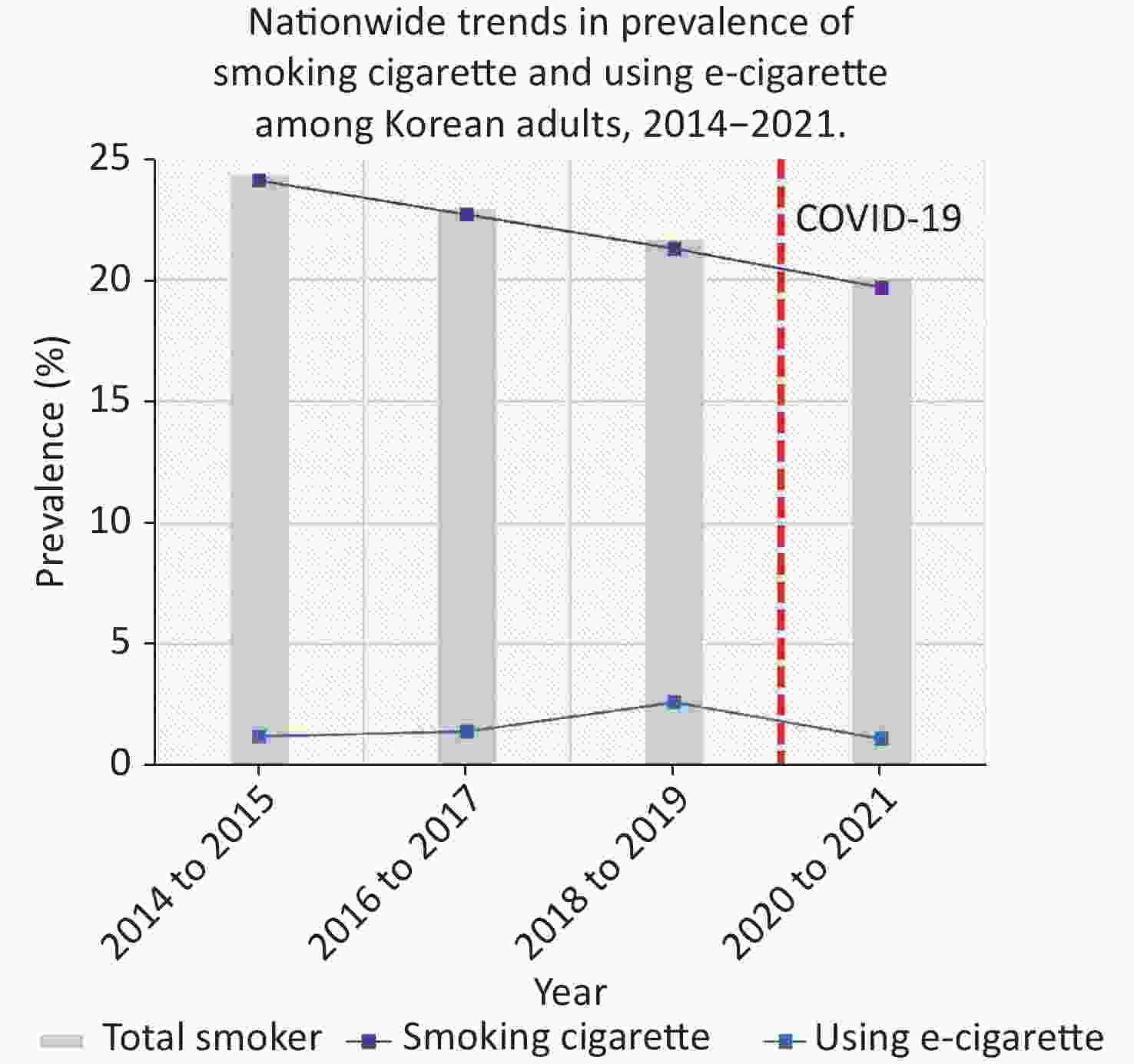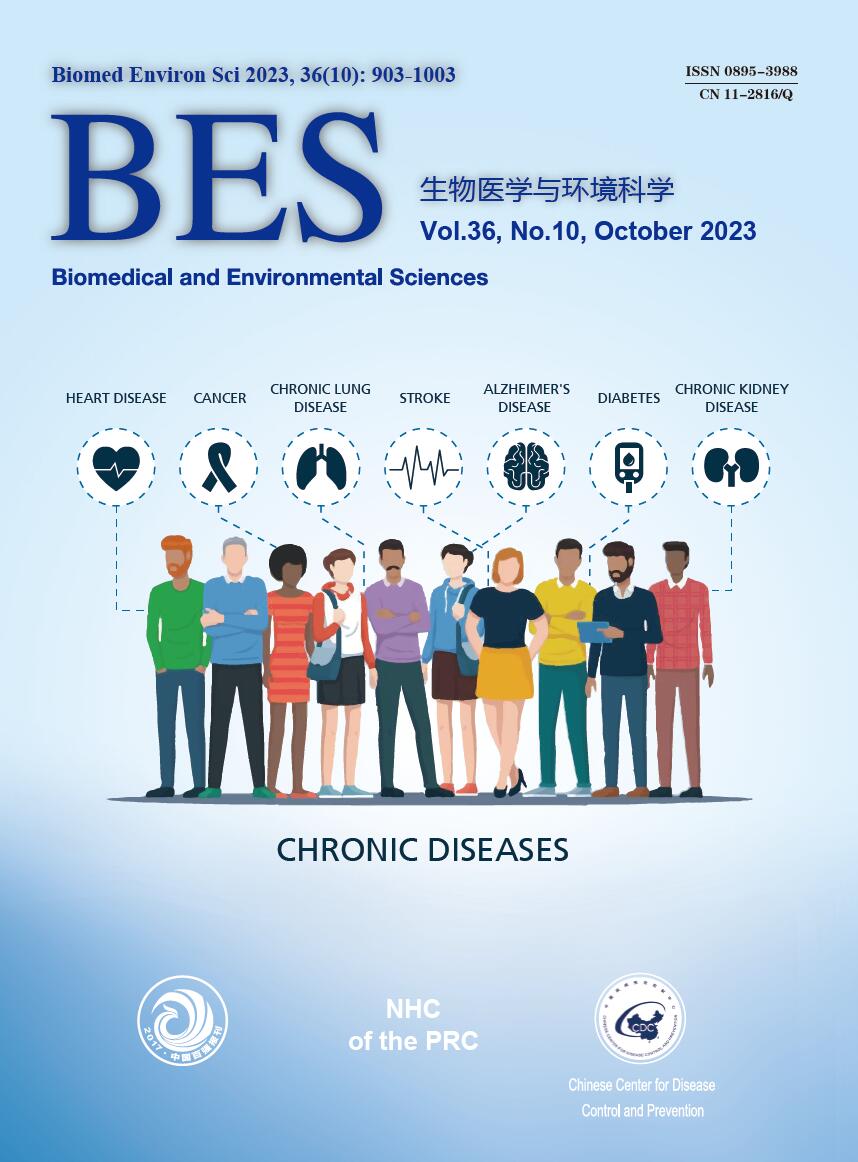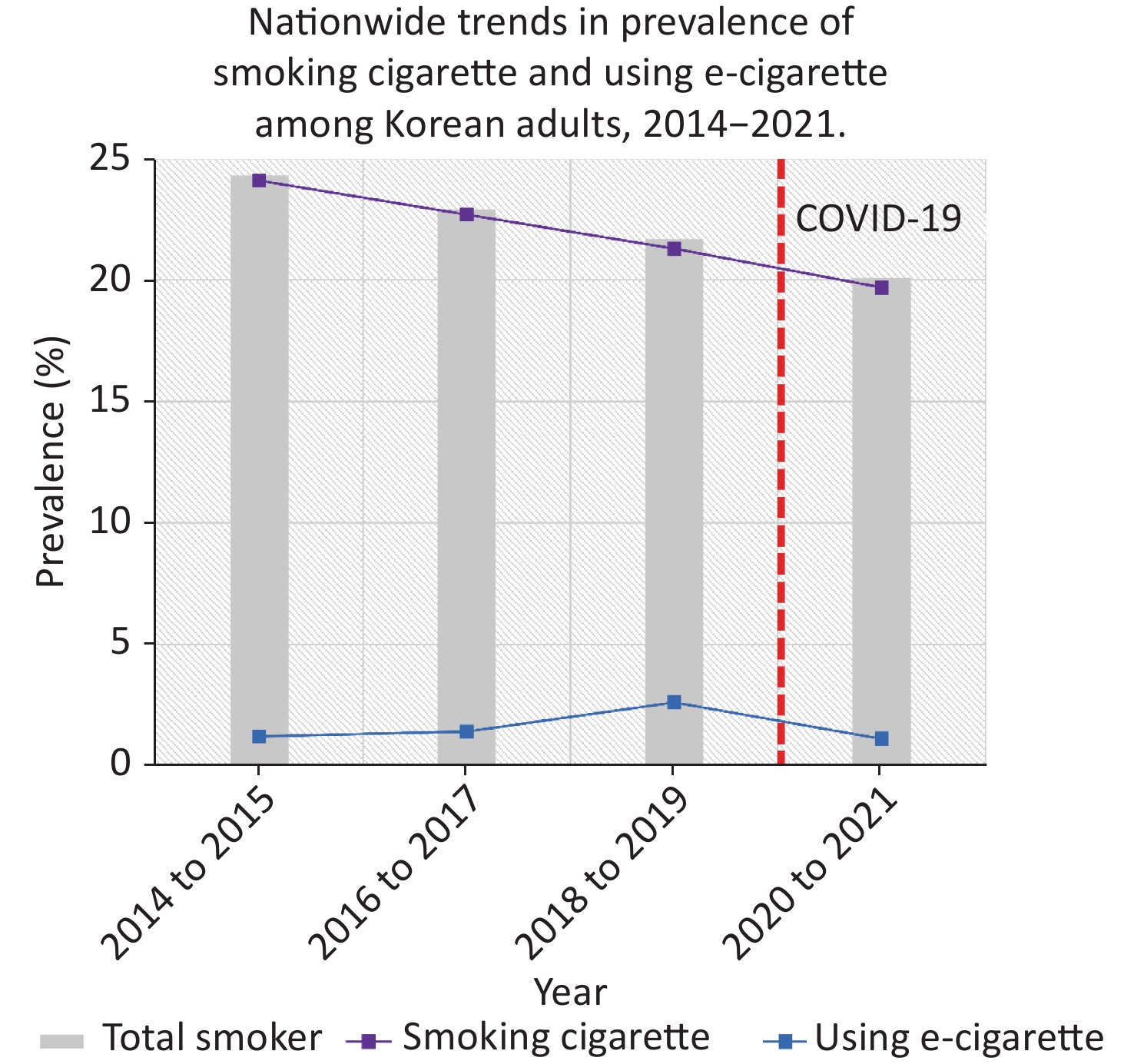-
Both cigarette and e-cigarette use cause respiratory tract damage and related health outcomes, and potentially increase the risk of coronavirus disease 2019 (COVID-19)-related symptoms[1]. Since the COVID-19 pandemic, local and central governments have legally mandated wearing masks indoors and outdoors[2]; thus, the inconvenience of smoking due to wearing masks and physical distancing has arisen[2]. Considering that the COVID-19 pandemic has continued for more than two years, little is known about how the pandemic will comprehensively affect the prevalence of cigarette and e-cigarette use[2]. Therefore, we aimed to comprehensively investigate the long-term prevalence of cigarette smoking and e-cigarette use before (2014 to 2019) and during the COVID-19 pandemic (2020 to 2021) among Korean adults. Furthermore, through a representative serial study of 1.2 million individuals, we investigated the long-term trends in the proportional differences between cigarette smoking and e-cigarette use in South Korea.
Data were obtained from the Community Health Survey (CHS), which was performed by the Korea Disease Control and Prevention Agency (KDCA). In this study, data were used for comparison before (2014–2019) and during the COVID-19 pandemic (2020–2021). The protocol used in the study was approved by the Korea Disease Control and Prevention Agency (KDCA) and Kyung Hee University (KHUH 2022-06-042). Written informed consent was obtained from all participants during enrollment.
The study sample consisted of adults (aged ≥ 19 years) living in South Korea between 2014 and 2021 (N = 1,539,982). We investigated the prevalence of cigarette and e-cigarette smoking before and during the COVID-19 pandemic. Participants (total excluded n = 257,383) with incomplete baseline information (n = 183,473), incomplete health-related outcomes (n = 73,616), and those with incomplete smoking status (n = 294) were excluded. Data from 1,282,599 individuals were used for analysis (total study participants; Figure 1).

Figure 1. Nationwide trends in the prevalence of smoking cigarettes and using e-cigarettes among Korean adults, 2014–2021.
Smoking was defined as having smoked a cigarette or used an e-cigarette within one year (in the past year or 12 months). In addition, a current smoker/user is defined as a person who smokes at least 100 cigarettes in his or her lifetime and currently smokes every day or for a few days[3]. Current smokers/users were divided into two groups: smoking cigarettes and e-cigarettes; dual users were not considered for the study. The questions on smoking and e-cigarette use were as follows: “Do you currently smoke regular cigarettes?” and “Do you currently use electronic cigarettes?”
We used CHS data from 2014 to 2021 to obtain the covariates as percentages with a 95% confidence interval (CI). The prevalence of cigarette smoking and the use of e-cigarettes were evaluated and compared from before and during the COVID-19 pandemic. We then combined and defined two consecutive years (2014–2015, 2016–2017, 2018–2019, and 2020–2021)[4] to stabilize each estimate with a 95% CI. Data were estimated using a linear regression model described as β-coefficients with a 95% CI and a binary logistic regression model as odds ratio (OR) with a 95% CI. Trend difference was calculated as the β-difference and odds ratio before (2014 to 2019) and during the pandemic (2020 to 2021), respectively[5]. Statistical analyses were performed using the SAS software (version 9.4; SAS Institute, Cary, NC, USA). Statistical significance was defined as a two-sided P-value < 0.05.
From 2014 to 2021, a total of 1,282,599 adults were registered on CHS, and smokers accounted for 22.4% (95% CI, 22.3 to 22.5) of the total. Among them, 20.8% were cigarette smokers (95% CI, 20.8 to 20.9) and 1.5% were e-cigarette users (95% CI, 1.5 to 1.6). Supplementary Table S1 (available in www.besjournal.com) summarizes the basic characteristics of the study population.
The changes in the prevalence of cigarette and e-cigarette use between 2014 and 2021 are shown in Figure 1 and Supplementary Table S2 (available in www.besjournal.com). The prevalence of smokers was 24.3% (95% CI, 24.2 to 24.4) from 2014 to 2015, 21.7% (95% CI, 21.5 to 21.8) from 2018 to 2019, and 20.1% (95% CI, 20.0 to 20.3) during the pandemic. Traditional smokers accounted for 23.1% (95% CI, 22.9 to 23.2) from 2014 to 2015, 19.1% (95% CI, 19.0 to 19.3) from 2018 to 2019, and 19.0% (95% CI, 18.9 to 19.2) during the pandemic. E-cigarette users accounted for 1.2% (95% CI, 1.2 to 1.3) from 2014 to 2015, 2.6% (95% CI, 2.5 to 2.6) from 2018 to 2019, and 1.1% (95% CI, 1.1 to 1.1) during the pandemic.
Supplementary Table S3 (available in www.besjournal.com) presents the OR (95% CI) for the prevalence of cigarette smoking and e-cigarette use before and during the pandemic. Compared to before the pandemic (2014 to 2019), the prevalence of total, cigarette, and e-cigarette smokers/users decreased by 0.842 (0.835 to 0.850; P < 0.001), 0.828 (0.820 to 0.835; P < 0.001), and 0.790 (0.766 to 0.815; P < 0.001), respectively, during the pandemic. Furthermore, stratification analysis by age, sex, region of residence, basic livelihood security recipient, income, educational background, occupational group, marital status, subjective health level, walking activities, body mass index (BMI), and depressive experience showed similar patterns in the overall results.
To the best of our knowledge, this is the first study to investigate the effects of the pandemic on trends in the prevalence of smoking status, including e-cigarette usage, among Korean adults, through a nationwide, long-term serial, and representative study of 1.2 million individuals. As a result, the prevalence of total cigarette smoking during the COVID-19 pandemic tended to decrease less than before the pandemic. Interestingly, the use of e-cigarettes increased before the COVID-19 pandemic, but decreased during the pandemic. Particularly, the prevalence of smokers who were unemployed and obese increased during the pandemic. Our findings suggest that the COVID-19 pandemic may have affected smoking status.
Although previous studies have investigated trends in the prevalence of smoking status, their findings have been inconclusive and inconsistent: decreasing trends were observed in the United States of America[6] and Hong Kong, China[7], whereas an increasing trend was observed in Italy[8]. A study in the United States[6] (n = 2,193,981) showed a trend of prevalence of smoking before and during the COVID-19 pandemic, but the study’s authors did not perform a stratification analysis of the distinction between using e-cigarettes and smoking cigarettes. In addition, Italy[8] (n = 6003), the United Kingdom[9] (n = 773), the United States[10] (n = 38), and Hong Kong, China[7] (n = 1,561) were only investigatedduring the early pandemic (2020) and had small sample sizes with non-representative enrolled samples, inadequate study designs (only cross-sectional studies), and short-term follow-up periods. In the United States[6] and Hong Kong, China[7] the questionnaires asked whether the smoking rate seemed to have increased or decreased since before COVID-19, rather than asking participants whether they smoked or not and looking at the prevalence based on statistics by period. Although previous studies have commonly included only the early stages of the pandemic (2020), few have investigated the prevalence of smoking status during the mid-pandemic (2021), which may lead to inadequate conclusions. Therefore, our study investigated the long-term trends in the prevalence of smoking status by tobacco products in 1.28 million adults, which may provide potential evidence of pandemic-related effects on smoking status.
This study has some limitations. First, the smoking status was assessed using a self-reported questionnaire. Additionally, participants’ health levels, walking activities, and depressive experiences may have been misclassified. This is because the individuals reflected on their own figures. Second, the data used in our study did not account for smoking frequency. The data only allowed us to observe changes in the number of smokers in the total population and the dose-dependent association between smoking frequency and the COVID-19 pandemic could not be calculated. Therefore, large-scale prospective studies on smoking frequency during the COVID-19 pandemic are warranted. Finally, our main results cannot rule out the possibility of natural trends and the confounding effects of other factors. Despite these limitations, this is the first large-scale, population-based, nationwide study to investigate smoking prevalence between 2014 and 2021, including the early/mid pandemic. In addition data were collected from a large population containing national data on smoking for over 1.2 million individuals.
We analyzed trends in the prevalence of cigarette smoking and e-cigarette use before and during the COVID-19 pandemic from 2014 to 2021, including the early/mid pandemic. Although our results could not rule out the possibility of natural trends and confounding factors, the prevalence of total smokers and smoking cigarettes decreased before the pandemic (2014 to 2019); however, it decreased less than expected during the pandemic (2020 to 2021). Although the prevalence of e-cigarette use increased before the pandemic, it decreased during the pandemic. Interestingly, unemployed and obese individuals had an increased prevalence of total cigarette and e-cigarette smoking during the pandemic. Our results provide an improved epidemiological understanding of smoking status before and during the COVID-19 pandemic and suggest that more individualized and precise strategies to prevent and quit smoking are needed to improve public and global health during the pandemic.
HTML
 22405附表1-3不用排版最后帮助添加页眉直接放网站.pdf
22405附表1-3不用排版最后帮助添加页眉直接放网站.pdf
|

|








 Quick Links
Quick Links
 DownLoad:
DownLoad: